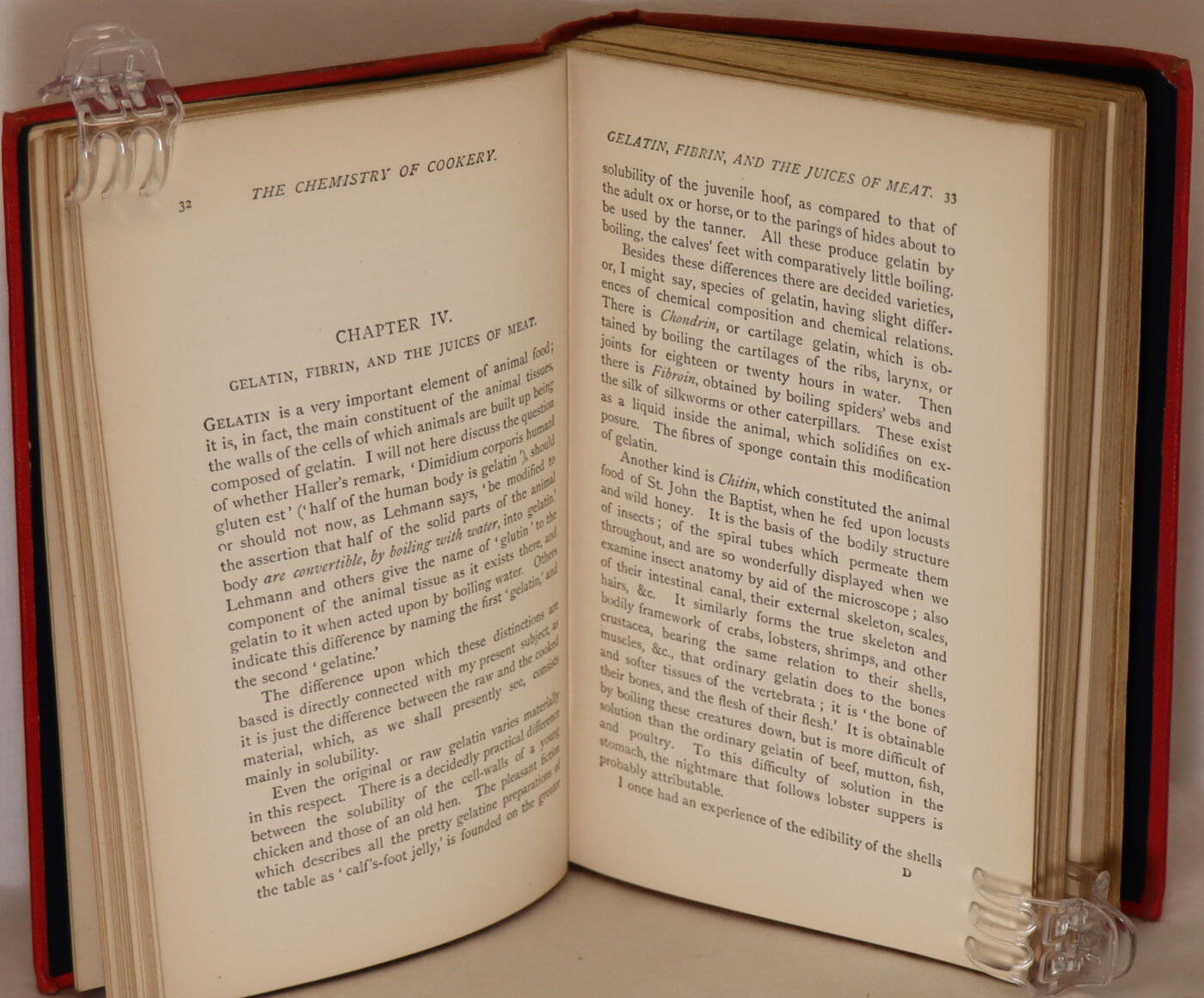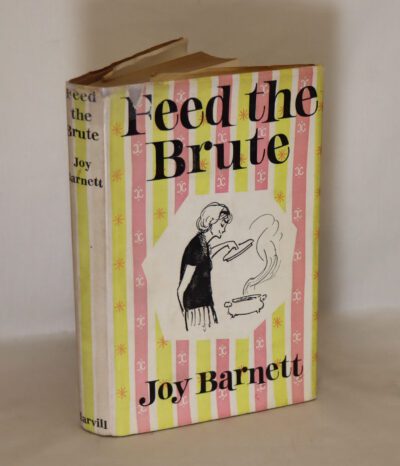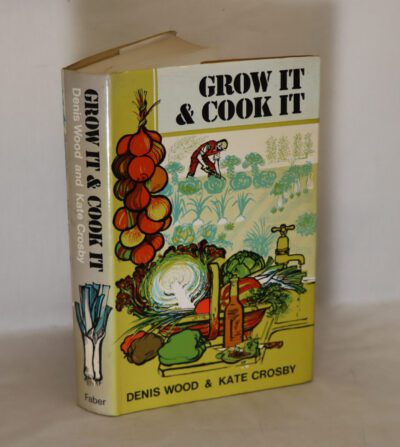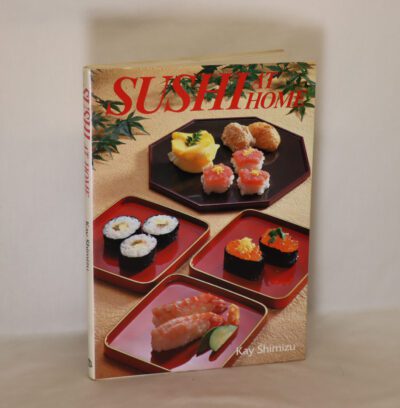The Chemistry of Cookery.
By W Mattieu Williams
Printed: 1898
Publisher: Chatto & Windus. London
Edition: Third edition
| Dimensions | 14 × 20 × 3 cm |
|---|---|
| Language |
Language: English
Size (cminches): 14 x 20 x 3
Condition: Very good (See explanation of ratings)
Your items
Item information
Description
Red cloth binding with gilt title on the spine.
We provide an in-depth photographic presentation of this item to stimulate your feeling and touch.More traditional book descriptions are immediately available
- Note: This book carries a £5.00 discount to those that subscribe to the F.B.A. mailing list
For conditions, please view our photographs. A nice clean rare original book from the library gathered by the famous Cambridge Don, computer scientist, food and wine connoisseur, Jack Arnold LANG. Jack founded the Midsummer House, Cambridge’s paramount restaurant. This dining experience is hidden amongst the grassy pastures and grazing cattle of Midsummer Common and perched on the banks of the River Cam.
This is a fantastic book, many decades before its time.
“The Chemistry of Cookery” by W. Mattieu Williams is a pioneering work that explores the scientific principles behind cooking. First published in the 19th century, the book merges chemistry and culinary arts, providing readers with an understanding of how different ingredients interact and transform during cooking processes. Williams meticulously breaks down the chemical reactions that occur when heat is applied, when ingredients are combined, and how these reactions affect flavor, texture, and nutritional value. The text serves not just as a cookbook but as a fundamental guide for aspiring cooks and food enthusiasts who are eager to elevate their culinary skills by grasping the science behind cooking techniques. Williams’ accessible writing demystifies complex concepts, making them approachable for the average reader. Overall, “The Chemistry of Cookery” remains a classic that emphasizes the importance of science in the kitchen, encouraging a deeper appreciation for the art of cooking.
William Mattieu Williams (6 February 1820 – 28 November 1892) was an English writer on science and education. The son of Abraham Williams, a fishmonger in London, and his wife Louise, daughter of Gabriel Mattieu, a Swiss refugee, he was born in London on 6 February 1820. He lost his father in infancy, and his mother married again when he was only four years old. After receiving an elementary education, he was apprenticed at the age of fourteen to Thomas Street, a mathematical and optical instrument maker in Lambeth. He attended evening classes at the London Mechanics’ Institution in Southampton Buildings, Chancery Lane. In 1841 he inherited a sum of money, and with his apprenticeship over, he spent two years at the University of Edinburgh, and a period on a walking tour through Europe, paying his way by working as an artisan. He spent time in Switzerland, Italy, Greece, and Turkey. On his return to England he went to Edinburgh to study medicine, but decided not to become a surgeon. He set up as an electrical instrument maker and electrotyper in Hatton Garden, London.
He also lectured about his tour and on other subjects at the Mechanics’ Institution, where he was a member of the committee of management. He helped to make the Institution accept William Ellis’s offer of money to found a school, which, as the “Birkbeck School”’ was opened on 17 July 1848. The success of this school led George Combe, whom Williams knew from Edinburgh, with the monetary support of Ellis, to found a similar institution in Edinburgh; Williams undertook the headmastership, and it was opened on 4 December 1848 under the title of the ‘Williams Secular School’ in the Trades’ Hall, Infirmary Street. Shortly it moved, after a rapid increase in its numbers, to the premises of the former anatomical school of Dr. Robert Knox at 1 Surgeons’ Square. In 1854, having been appointed master of the science classes in the recently opened Birmingham and Midland Institute, Williams moved there and delivered his opening lecture on 17 August 1854. In 1856 he introduced the successful “Institute penny lectures”. In 1857 he became acquainted with Felice Orsini, and taught him something about manufacturing explosives, of interest to the Carbonari plotters. Later he turned his attention to the chemistry and manufacture of paraffin, and was appointed manager of the Leeswood Oil Company in 1863, when he left Birmingham for Caergwrle, Flintshire. After the decline of the Welsh oil-distilling industry following the discovery of oil fields in the USA, Williams went in 1868 to Sheffield as chemist to the Atlas Iron Works of Sir John Brown & Co.
In 1870 Williams moved to London, and devoted his time to scientific writing. He delivered the Cantor lectures in 1876, taking for his subject ‘Iron and Steel Manufacture,’ and again in 1878, when he spoke on ‘Mathematical Instruments.’ On the death of his stepfather’s brother, Zachariah Watkins, early in 1889, he came into money, and began at the age of sixty-nine what he described as his life-work, the Vindication of Phrenology. While revising the completed manuscript he died suddenly at his residence, The Grange, Neasden, on 28 November 1892. He was buried at West Norwood Cemetery.
Want to know more about this item?

Related products
Share this Page with a friend












